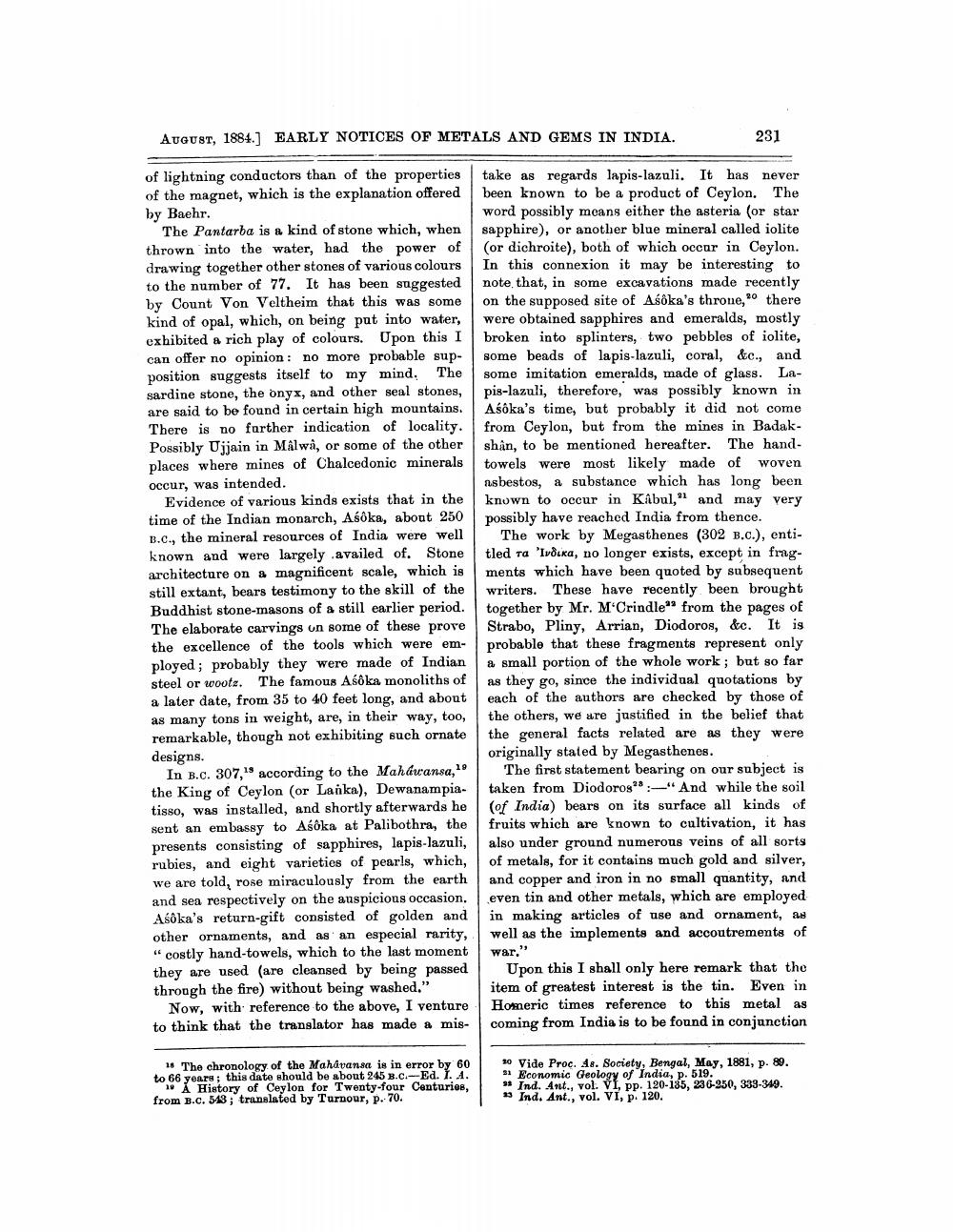________________
AUGUST. 1884.) EARLY NOTICES OF METALS AND GEMS IN INDIA.
231
of lightning conductors than of the properties of the magnet, which is the explanation offered by Baehr.
The Pantarba is a kind of stone which, when thrown into the water, had the power of drawing together other stones of various colours to the number of 77. It has been suggested by Count Von Veltheim that this was some kind of opal, which, on being put into water, exhibited a rich play of colours. Upon this I can offer no opinion: no more probable supposition suggests itself to my mind. The sardine stone, the onyx, and other seal stones, are said to be found in certain high mountains. There is no further indication of locality. Possibly Ujjain in Malwà, or some of the other places where mines of Chalcedonic minerals occur, was intended.
Evidence of various kinds exists that in the time of the Indian monarch, Asoka, about 250 B.C., the mineral resources of India were well known and were largely availed of. Stone architecture on a magnificent scale, which is still extant, bears testimony to the skill of the Buddhist stone-masons of a still earlier period. The elaborate carvings on some of these prove the excellence of the tools which were employed; probably they were made of Indian steel or woote. The famous Asoka monoliths of a later date, from 35 to 40 feet long, and about as many tons in weight, are, in their way, too, remarkable, though not exhibiting such ornate designs.
In B.c. 307,"s according to the Mahávansa, the King of Ceylon (or Lanka), Dewanampiatisso, was installed, and shortly afterwards he sent an embassy to Asoka at Palibothra, the presents consisting of sapphires, lapis lazuli, rubies, and eight varieties of pearls, which, we are told, rose miraculously from the earth and sea respectively on the auspicious occasion. Asoka's return-gift consisted of golden and other ornaments, and as an especial rarity, "costly hand-towels, which to the last moment they are used (are cleansed by being passed through the fire) without being washed."
Now, with reference to the above, I venture to think that the translator has made a mis
take as regards lapis-lazuli. It has never been known to be a product of Ceylon. The word possibly means either the asteria (or star sapphire), or another blue mineral called iolite (or dichroite), both of which occur in Ceylon. In this connexion it may be interesting to note that, in some excavations made recently on the supposed site of Asoka's throne, there were obtained sapphires and emeralds, mostly broken into splinters, two pebbles of iolite, some beads of lapis lazuli, coral, &c., and some imitation emeralds, made of glass. Lapis-lazuli, therefore, was possibly known in Asoka's time, but probably it did not come from Ceylon, but from the mines in Badakshận, to be mentioned hereafter. The handtowels were most likely made of woven nsbestos, a substance which has long been known to occur in Kabul," and may very possibly have reached India from thence.
The work by Megasthenes (302 B.C.), entitled ta 'Ivoika, no longer exists, except in fragments which have been quoted by subsequent writers. These have recently been brought together by Mr. M'Crindle" from the pages of Strabo, Pliny, Arrian, Diodoros, &c. It is probable that these fragments represent only a small portion of the whole work; but so far as they go, since the individual quotations by each of the authors are checked by those of the others, we are justified in the belief that the general facts related are as they were originally stated by Megasthenes.
The first statement bearing on our subject is taken from Diodorog? :-"And while the soil (of India) bears on its surface all kinds of fruits which are known to enltivation, it has also under ground numerous veins of all sorts of metals, for it contains much gold and silver, and copper and iron in no small quantity, and even tin and other metals, which are employed in making articles of use and ornament, as well as the implements and accoutrements of war."
Upon this I shall only here remark that the item of greatest interest is the tin. Even in Homeric times reference to this metalas coming from India is to be found in conjunction
15 The chronology of the Maharansa is in error by 60 to 66 years; this date should be about 245 B.C.-Ed. 1.4.
10 A History of Ceylon for Twenty-four Centuries, from B.C. 543; translated by Turnour, p. 70.
0 Vide Proc. 18. Society, Bengal, May, 1881, p. 89. S1 Economic Geology of India, p. 519. * Ind. Ant., vol. V1, pp. 120-135, 236-250, 333-349.
Ind. Ant., vol. VI, p. 120.




